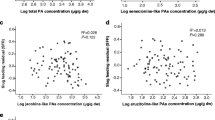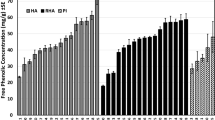Abstract
Three saponins and two sapogenins had differential effects on food consumption in five near-isogenic flea beetle lines, which differ in their ability to utilize a novel host plant, Barbarea vulgaris (Brassicaceae). The ability to live on this plant is controlled by major, dominant R-genes in the flea beetle, Phyllotreta nemorum (Coleoptera: Chrysomelidae: Alticinae). A susceptible genotype (rr) is unable to live on the plant, whereas resistant genotypes (RR and Rr) can utilize the novel host plant. Among compounds isolated from B. vulgaris, hederagenin cellobioside (hederagenin-3-O-(4-O-β-D-glucopyranosyl)-β-D-glucopyranoside) inhibited feeding, whereas the effect of oleanolic acid cellobioside was much weaker. The aglycones (sapogenins) were inactive. Although hederagenin cellobioside was active against all flea beetle lines, its effect on food consumption was much stronger on the susceptible genotype (rr) compared to the resistant genotype (Rr). Susceptible and resistant flea beetle genotypes were equally sensitive to a non-host saponin, α-hederin (hederagenin-3-O-(2-O-α-L-rhamnopyranosyl)-α-L-arabinopyranoside). These results suggest that R-alleles in flea beetles might be specific adaptations to defensive saponins in B. vulgaris. A possible mechanism of action of the R-alleles might be to encode for an enzyme (e.g. a glucosidase), which is able to cleave glycosidic bonds in hederagenin cellobioside, but not in α-hederin. The potential role of saponins as defensive compounds in B. vulgaris and as targets for counter-adaptations in flea beetles and other insects is discussed.

Similar content being viewed by others
References
Adel, M. M., Sehnal, F., and Jurzysta, M. 2000. Effect of alfalfa saponins on the moth Spodoptera littoralis. J. Chem. Ecol. 26: 1065–1078.
Agerbirk, N., Olsen, C. E., and Nielsen, J. K. 2001. Seasonal variation in leaf glucosinolates and insect resistance in two types of Barbarea vulgaris ssp. arcuata. Phytochemistry 58: 91–100.
Agerbirk, N., Olsen, C. E., Bibby, B. M., Frandsen, H. O., Brown, L. D., Nielsen, J. K., and Renwick, J. A. A. 2003a. A saponin correlated with variable resistance of Barbarea vulgaris to the diamondback moth Plutella xylostella. J. Chem. Ecol. 29: 1417–1433.
Agerbirk, N., Ørgaard, M., and Nielsen, J. K. 2003b. Glucosinolates, flea beetle resistance, and leaf pubescence as taxonomic characters in the genus Barbarea (Brassicaceae). Phytochemistry 63: 69–80.
Argentieri, M. P., D’Addabbo, T., Tava, A., Agostinelli, A., Jurzysta, M., and Avato, P. 2008. Evaluation of nematicidal properties of saponins from Medicago spp. Eur. J. Plant Pathol. 120: 189–197.
Badenes-Perez, F. R., Nault, B. A., and Shelton, A. M. 2006. Dynamics of diamondback moth oviposition in the presence of a highly preferred non-suitable host. Entomol. Exp. Appl. 120: 23–31.
Börjesdotter, D. 2000. Barbarea verna and Barbarea vulgaris as host plants for the pollen beetle (Meligethes aeneus). J. Agr. Sci. 134: 213–220.
Bowyer, P., Clarke, B. R., Lunness P., Daniels, M. J., and Osbourn, A. E. 1995. Host range of a plant pathogenic fungus determined by a saponin detoxifying enzyme. Science 267: 371–374.
Ehrlich, P. R. and Raven, P. H. 1964. Butterflies and plants: a study in coevolution. Evolution 18: 586–608.
Feeny, P. 1977. Defensive ecology of the Cruciferae. Ann. Mo. Bot. Gard. 64: 221–234.
Futuyma, D. J. and Keese, M. C. 1992. Evolution and coevolution of plants and phytophagous arthropods, pp. 439–475 in G. A. Rosenthal and M. R. BERENBAUM (eds.). Herbivores. Their Interactions with Secondary Plant Metabolites, 2nd Edition, Vol. II: Ecological and Evolutionary Processes. Academic Press, San Diego.
Glendinning, J. I. 2002. How do herbivorous insects cope with noxious secondary plant compounds in their diet? Entomol. Exp. Appl. 104: 15–25.
Golawska, S. 2007. Deterrence and toxicity of plant saponins for the pea aphid, Acyrthosiphon pisum Harris. J. Chem. Ecol. 33: 1598–1606.
Gomulkiewicz, R., Drown, D. M., Dybdahl, M. F., Godsoe, W., Nuismer, S. L., Pepin, K. M., Ridenhour, B. J., Smith, C. I., and Yoder, J. B. 2007. Dos and don’ts of testing the geographic mosaic theory of coevolution. Heredity 98: 249–258.
Hartmann, T. 1996. Diversity and variability of plant secondary metabolism: a mechanistic view. Entomol. Exp. Appl. 80: 177–188.
Huang, X. and Renwick, J. A. A. 1994. Cardenolides as oviposition deterrents to two Pieris species: Structure-activity relationships. J. Chem. Ecol. 20: 1039–1051.
Huang, X., Renwick, J. A. A., and Sachdev-Gupta, K. 1993. Oviposition stimulants and deterrents regulating differential acceptance of Iberis amara by Pieris rapae and P. napi oleracea. J. Chem. Ecol. 19: 1645–1663.
Huang, H. -C., Liao, S. -C., Chang, F. -R., Kuo, Y. -H., and Wu, Y. -C. 2003. Molluscicidal saponins from Sapindus mukorossi, inhibitory agents of the golden apple snails, Pomacea canaliculata. J. Agric. Food Chem. 51: 4916–4919.
De Jong, P. W., Frandsen, H. O., Rasmussen, L., and Nielsen, J. K. 2000. Genetics of resistance against defenses of the host plant Barbarea vulgaris in a Danish flea beetle population. Proc. R. Soc. Lond. B Biol. Sci. 267: 1663–1670.
De Jong, P. W., Breuker, C. J., De Vos, H., Vermeer, K. M. C. A., Oku, K.,Verbaarschot, P., Nielsen, J. K., and Brakefield, P. M. 2009. Genetic differentiation between resistance phenotypes in the phytophagous flea beetle, Phyllotreta nemorum. J. Insect Science 9: 75.
Kuzina, V., Ekstrøm, C. T., Andersen, S. B., Nielsen, J. K., Olsen, C. E., and Bak, S. 2009. Identification of defense compounds in Barbarea vulgaris against the herbivore Phyllotreta nemorum by an ecometabolomic approach. Plant Physiol. (in press).
Morant, A. V., Jørgensen, K., Jørgensen, C., Paquette S. M., Sanchez-Perez, R., Møller, B. L., and Bak, S. 2008. β-Glucosidases as detonators of plant chemical defense. Phytochemistry 69: 1795–1813.
Morrissey, J. P., Wubben, J. P., and Osbourn, A. E. 2000. Stagonospora avenae secretes multiple enzymes that hydrolyze oat leaf saponins. Mol. Plant-Microbe Interact. 13: 1041–1052.
Nagao, T., Tanaka, R., and Okabe, H. 1991. Studies on the constituents of Aster scaber Thunb. I. Structures of scaberosides, oleanolic acid glycosides isolated from the root. Chem. Pharm. Bull. 39: 1699–1703.
Nielsen, J. K. 1978. Host plant discrimination within Cruciferae: Feeding responses of four leaf beetles (Coleoptera: Chrysomelidae) to glucosinolates, cucurbitacins and cardenolides. Entomol. Exp. Appl. 24: 41–54.
Nielsen, J. K. 1997a. Variation in defenses of the plant Barbarea vulgaris and in counter-adaptations by the flea beetle Phyllotreta nemorum. Entomol. Exp. Appl. 82: 25–35.
Nielsen, J. K. 1997b. Genetics of the ability of Phyllotreta nemorum larvae to survive in an atypical host plant Barbarea vulgaris ssp. arcuata. Entomol. Exp. Appl. 82: 37–44.
Nielsen, J. K. 1999. Specificity of a Y-linked gene in the flea beetle Phyllotreta nemorum for defenses in Barbarea vulgaris. Entomol. Exp. Appl. 91: 359–368.
Nielsen, J. K and De Jong, P. W. 2005. Temporal and host-related variation in frequencies of genes which enable Phyllotreta nemorum to utilize a novel host plant, Barbarea vulgaris. Entomol. Exp. Appl. 115: 265–270.
Nielsen, J. K., Larsen, L. M., and Sørensen, H. 1977. Cucurbitacin E and I in Iberis amara: Feeding inhibitors for Phyllotreta nemorum. Phytochemistry 16: 1519–1522.
Osbourn, A. E. 1996. Saponins and plant defense—a soap story. Trends Plant Sci. 1: 4–9.
Ratzka, A., Vogel, H., Kliebenstein, D. J., Mitchell-Olds, T., and Kroymann, J. 2002. Disarming the mustard oil bomb. Proc. Natl. Acad. Sci. U. S. A. 99: 11223–11228.
Renwick, J. A. A. 2002. The chemical world of crucivores: lures, treats and traps. Entomol. Exp. Appl. 104: 35–42.
Sachdev-Gupta, K., Radke, C. D., and Renwick, J. A. A. 1993a. Antifeedant activity of cucurbitacins from Iberis amara against larvae of Pieris rapae. Phytochemistry 33: 1385–1388.
Sachdev-Gupta, K., Radke, C. D., Renwick, J. A., and Dimock, M. B. 1993b. Cardenolides from Erysimum cheiranthoides: Feeding deterrents to Pieris rapae larvae. J. Chem. Ecol. 19: 1355–1369.
Schoonhoven, L. M., Van Loon, J. J. A., and Dicke, M. 2005. Insect-Plant Biology. Oxford University Press, Oxford.
Shinoda, T., Nagao, T., Nakayama, M., Serizawa, H., Koshioka, M., Okabe, H., and Kawai, A. 2002. Identification of a triterpenoid saponin from a crucifer, Barbarea vulgaris, as a feeding deterrent to the diamond back moth, Plutella xylostella. J. Chem. Ecol. 28: 587–599.
Thompson, J. N. 1994. The Coevolutionary Process. The University of Chicago Press, Chicago.
Thompson, J. N. 2005. The Geographic Mosaic of Coevolution. The University of Chicago Press. Chicago and London.
Van Leur, H., Vet, L. E. M., Van Der Putten, W. H., and Van Dam, N. M. 2008. Barbarea vulgaris glucosinolate phenotypes differentially affect performance and preference of two different species of lepidopteran herbivores. J. Chem. Ecol. 34: 121–131.
Wittstock, U., Agerbirk, N., Stauber, E. J., Olsen, C. E., Hippler, M., Mitchell-Olds, T., Gershenzon, J., and Vogel, H. 2004. Successful herbivore attack due to metabolic diversion of a plant chemical defense. Proc. Natl. Acad. Sci. U. S. A. 101: 4859–4864.
Acknowledgements
We thank David B. Collinge, Manabu Kamimura, Tamara van Mölken, Mari-Anne Newman, Carl Erik Olsen, and Vera Kuzina Poulsen for helpful comments on the manuscript. The work was supported by grants from The Danish Natural Science Research Council (21-02-0534) and The Danish Agency for Science, Technology and Innovation (274-06-0370).
Author information
Authors and Affiliations
Corresponding author
Additional information
Tsuneatsu Nagao deceased: Sept 24, 2002.
Rights and permissions
About this article
Cite this article
Nielsen, J.K., Nagao, T., Okabe, H. et al. Resistance in the Plant, Barbarea vulgaris, and Counter-Adaptations in Flea Beetles Mediated by Saponins. J Chem Ecol 36, 277–285 (2010). https://doi.org/10.1007/s10886-010-9758-6
Received:
Revised:
Accepted:
Published:
Issue Date:
DOI: https://doi.org/10.1007/s10886-010-9758-6




